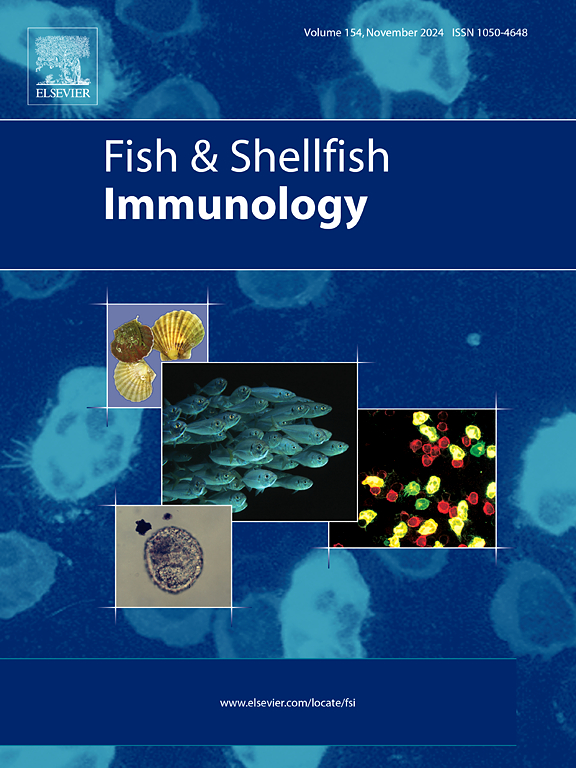m6A methylation dynamically participates in the immune response against Vibrio anguillarum in half-smooth tongue sole (Cynoglossus semilaevis)
IF 4.1
2区 农林科学
Q1 FISHERIES
引用次数: 0
Abstract
N6-methyladenosine (m6A) is the most prevalent RNA modification and a multifaceted regulator capable of affecting various aspects of mRNA metabolism, thereby playing important roles in numerous physiological processes. However, it is still unknown whether, when, and to what extent m6A modulation are implicated in the immune response of an economically important aquaculture fish, half-smooth tongue sole (Cynoglossus semilaevis). Herein, we systematically profiled and characterized the m6A epitranscriptome and transcriptome in C. semilaevis after the infection of Vibrio anguillarum. We demonstrated that m6A could be modulated as early as 4-h post infection (hpi), and the overall intensity of m6A methylation was enhanced following infection. Both conservative and novel motifs were uncovered from the m6A modification sites. Furthermore, differentially m6A methylated genes (DMGs) and differentially expressed genes (DEGs) were identified, and functional enrichment revealed multiple immune-related pathways, especially the FoxO signaling pathway which showed significance in every comparison. Joint analysis highlighted the remarkedly dynamic role of m6A on gene expression, i.e. early on, m6A mainly prioritized the down-regulation of specific genes, and later, it switched gears to promote expression of another set of genes. Moreover, key candidate genes, mainly involved in immunity and energy metabolism, were identified. Validations were performed by qPCR and MeRIP-qPCR. To our limited knowledge, this is the first study comprehensively characterizing the global m6A atlas in aquaculture fish species. The presented results provide new insights into the dynamics of m6A modifications in the transcriptome of the half-smooth tongue sole following bacterial infection, and further studies are warranted to elucidate the functional significance of these changes in depth.
m6A甲基化动态参与半光滑舌底(Cynoglossus semiaevis)对鳗弧菌的免疫应答。
n6 -甲基腺苷(n6 - methylladenosine, m6A)是一种最常见的RNA修饰物,也是一种多方面的调节剂,能够影响mRNA代谢的各个方面,从而在许多生理过程中发挥重要作用。然而,目前尚不清楚m6A调节是否、何时以及在多大程度上与一种经济上重要的水产养殖鱼类半光滑舌鳎(Cynoglossus semiaevis)的免疫反应有关。在此,我们系统地分析和表征了C. semiaevis感染鳗弧菌后的m6A表转录组和转录组。我们证明m6A可以在感染后4小时(hpi)被调节,并且感染后m6A甲基化的总体强度增强。从m6A修饰位点发现了保守的和新的基序。此外,还鉴定了m6A差异甲基化基因(dmg)和差异表达基因(DEGs),功能富集揭示了多种免疫相关途径,特别是FoxO信号通路,在各比较中均显示出显著性。联合分析发现,m6A对基因表达的影响是再显著的动态作用,即m6A在早期主要优先下调特定基因的表达,后来又转而促进另一组基因的表达。此外,还确定了主要参与免疫和能量代谢的关键候选基因。采用qPCR和MeRIP-qPCR进行验证。据我们所知,这是第一个全面表征全球水产养殖鱼类m6A图谱的研究。本研究结果为细菌感染后半光滑舌底转录组中m6A修饰的动态变化提供了新的见解,需要进一步的研究来深入阐明这些变化的功能意义。
本文章由计算机程序翻译,如有差异,请以英文原文为准。
求助全文
约1分钟内获得全文
求助全文
来源期刊

Fish & shellfish immunology
农林科学-海洋与淡水生物学
CiteScore
7.50
自引率
19.10%
发文量
750
审稿时长
68 days
期刊介绍:
Fish and Shellfish Immunology rapidly publishes high-quality, peer-refereed contributions in the expanding fields of fish and shellfish immunology. It presents studies on the basic mechanisms of both the specific and non-specific defense systems, the cells, tissues, and humoral factors involved, their dependence on environmental and intrinsic factors, response to pathogens, response to vaccination, and applied studies on the development of specific vaccines for use in the aquaculture industry.
 求助内容:
求助内容: 应助结果提醒方式:
应助结果提醒方式:


